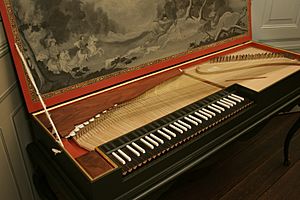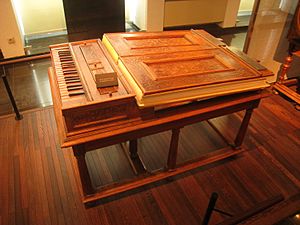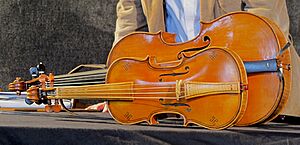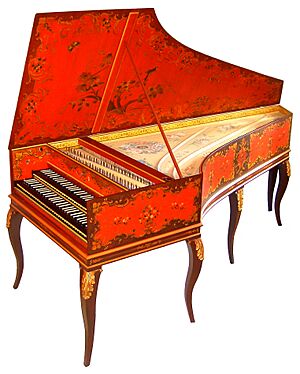List of period instruments facts for kids

When musicians play classical music today, they often use modern instruments. But sometimes, they want to play the music exactly as it sounded when it was first written. This is called "historically informed performance." It means they try to use the same kinds of instruments that composers like Bach or Mozart used.
These special instruments are called "period instruments." They are either very old instruments that have been fixed up, or new instruments built to look and sound just like the old ones. This article lists some of these cool instruments from different time periods in European history. Some of these instruments are not used much anymore, while others are early versions of instruments we still use today.
Contents
Renaissance (1400–1600)
The Renaissance was a time of great art and discovery, from about 1400 to 1600. Music also changed a lot during this period. Composers wrote new kinds of songs and pieces. Musicians used instruments that were common then.

Strings
- Violin
- Viol
- Viola
- Cello
- Lira da braccio
- Contrabass
- Violone
- Lute
- Theorbo
- Archlute
- Gittern
- Mandore
- Harp
- Cittern
- Vihuela
Woodwinds
Brasses
Keyboards
Percussion
Baroque (1600–1750)
The Baroque period followed the Renaissance, lasting from about 1600 to 1750. This era is known for its grand and dramatic music. Famous composers like Bach and Handel wrote many pieces for these instruments.
Strings
- Violino piccolo
- Violin
- Viol
- Viola da gamba
- Viola
- Viola d'amore
- Viola pomposa
- Tenor violin
- Cello
- Violoncello piccolo
- Contrabass
- Colascione
- Violone
- Lute
- Theorbo
- Archlute
- Angélique
- Mandore
- Mandolin
- Baroque guitar
- Harp
- Hurdy-gurdy
Woodwind
- Baroque flute
- Chalumeau
- Kortholt (also known as Cortholt, Curtall, Oboe family)
- Dulcian
- Baroque oboe
- Rackett
- Recorder
- Oboe d'amore
- Oboe da caccia
- Contrabassoon
- Taille
- Cor anglais
Brasses
Keyboards
Percussion
- Drum
- Timpani
- Cymbals
- Bass drum
- Tabor
- Snare drum
Classical (1750–1820)
The Classical period, from about 1750 to 1820, brought a new style of music. It was often lighter and clearer than Baroque music. Composers like Mozart and Beethoven wrote many famous pieces during this time. Instruments also continued to change and develop.
Strings
Woodwinds
- Basset clarinet
- Basset horn
- Clarinette d'amour
- Clarinet
- Chalumeau
- Flute
- Oboe
- Bassoon
- Contrabassoon
- Cor anglais
Keyboards
- Clavichord
- Harpsichord
- Spinet
- Tangent piano
- Fortepiano (early Piano)
- Organ
Brasses
- Buccin
- Ophicleide—a Serpent replacement, an early version of the Tuba
- Natural trumpet
- Natural horn
- Trombone
- Post horn
Percussion
See also
 In Spanish: Anexo:Instrumentos de época para niños
In Spanish: Anexo:Instrumentos de época para niños




